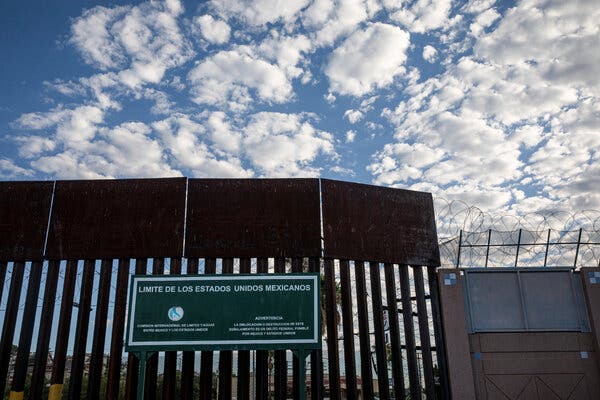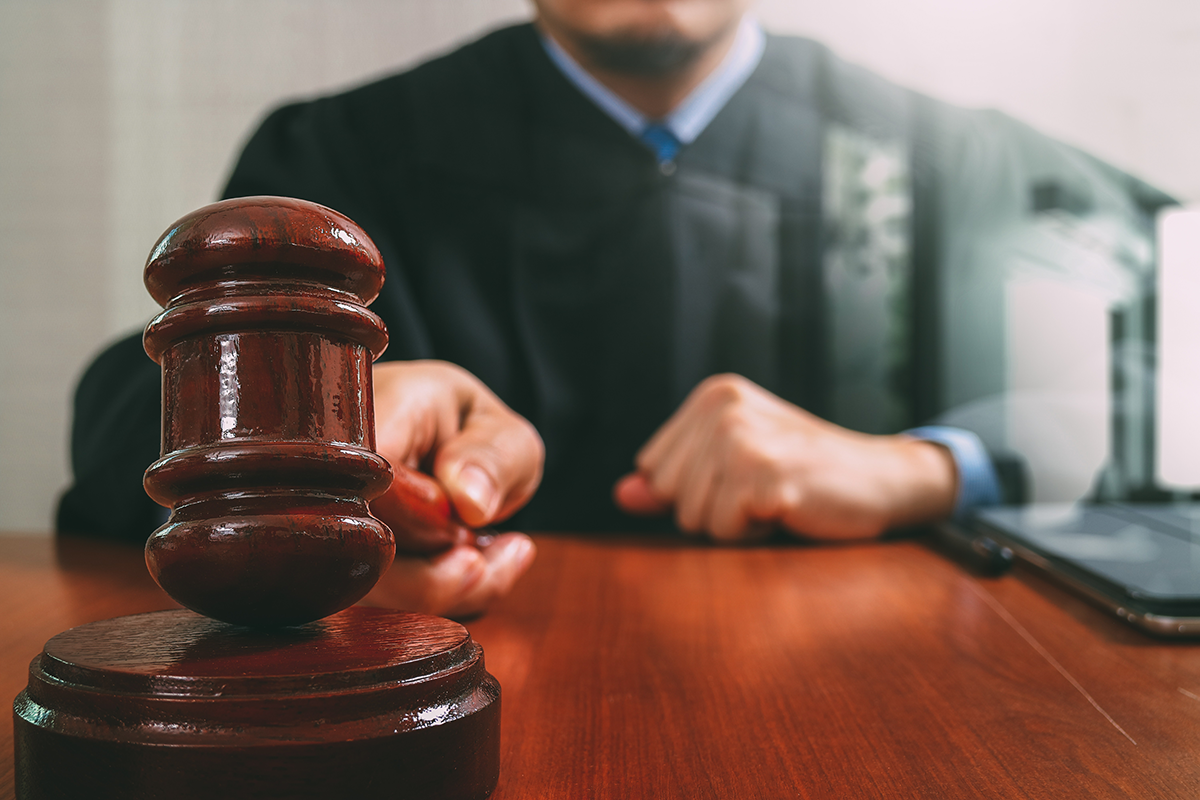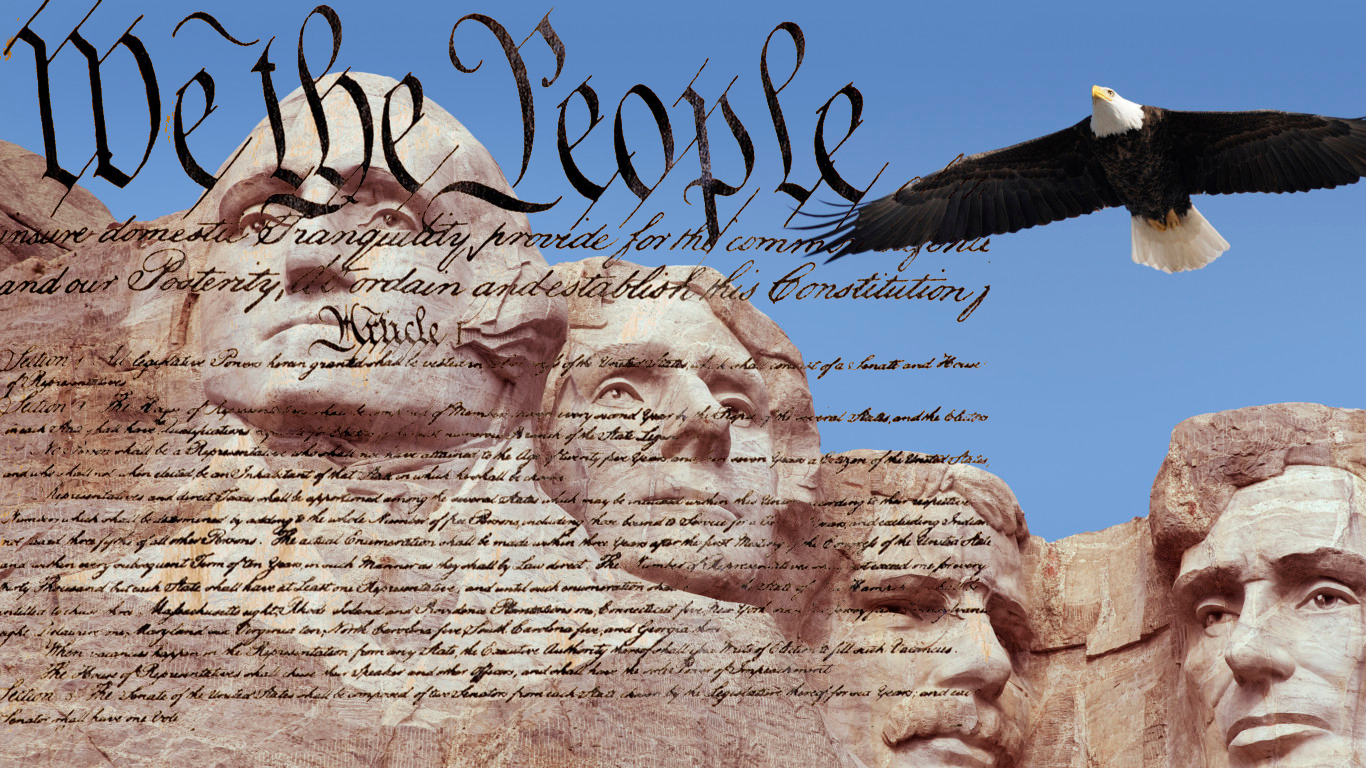The "Migrant Caravan" is now set to attempt to cross the Mexican border into the…
Enforcement / ICE / DHS
After a Lull, the Number of Migrants Trying to Enter the U.S. Has Soared

The number of immigrants arrested at the southwestern border has more than doubled since the spring, fueled by Mexico’s economic slump and a Trump administration policy that migrants say works in their favor. NOGALES, Mexico — Illegal migration along the southwest border of the United States has surged after a period of stagnation,,
NOGALES, Mexico — Illegal migration along the southwest border of the United States has surged after a period of stagnation, as economic hardship, made worse by the pandemic, has driven thousands northward seeking work.
After plunging in the spring, when nations went into lockdown and shut down borders in an effort to curb the spread of the virus, the number of migrants arrested along the United States border with Mexico more than doubled between April and July, according to the U.S. government.
As the numbers rise, immigration is becoming once again a primary rallying cry for President Trump, who is trailing in the polls in his bid for re-election and looking for purchase with an electorate that is increasingly unhappy with his handling of the pandemic and the economy.
“Despite the dangers posed by Covid-19, illegal immigration — it continues,” Mark Morgan, the acting commissioner of Customs and Border Protection, said on Thursday.
Undocumented migrants were “putting American lives at risk,” he added, although the United States leads the world in the number of deaths from the coronavirus.
Mr. Morgan touted the necessity of continuing to build the border wall, a project central to Mr. Trump’s political identity, to forestall illegal migration and the further spread of the coronavirus by infected undocumented immigrants.

The numbers are still far below the peak of the migration crisis in 2019, and also far lower than the record highs set in the 1980s, 1990s and 2000s, when annual tallies of migrants apprehended at the southwest border often topped 1,000,000.
And while undocumented migration is rebounding from a brief lull, who is coming — and why — has changed significantly since the pandemic. Many say they have been inspired to try to migrate now because of a new Trump administration policy that returns them to Mexico quickly, often within hours of being captured, but has the unintended effect of giving them more chances to cross the border illegally.
During the past several years, Central Americans dominated the flow of migrants trying to cross the southwest border, with many seeking asylum. They often traveled as families, frequently with children, and peacefully surrendered to American border agents in the hope of getting a chance to apply for sanctuary.
Now, many Central Americans who might otherwise have sought to migrate have been discouraged from leaving home by closed borders and other pandemic-related travel restrictions, migrants’ advocates said. And word has gotten back to potential refugees fleeing persecution that under the Trump administration’s restrictive immigration policies, there is little chance now of securing asylum in the United States.
Instead, the vast majority of those caught trying to cross into the United States in recent months are Mexican, officials and migrants’ advocates said. And their encounters with the authorities were often chaotic, with migrants scattering into the desert to evade capture.
“They’re running, they’re fighting,” Mr. Morgan said. “They absolutely have no appreciation for the deadly consequences of their actions while we’re navigating a global, deadly pandemic.”
Mexico has been among the countries worst affected by the coronavirus pandemic, with nearly 49,000 reported dead — behind only much larger Brazil and the United States. The real number of lives lost is believed to be much higher because of a dearth of testing and a significant undercount of cases.
Millions lost their jobs amid a mounting recession that economists expect to be the deepest in nearly a century, but the government has eschewed the stimulus measures that other nations used to prop up economies as they buckled under the weight of the pandemic.
In July, 78 percent of those apprehended on the southwestern border were from Mexico, mainly single adult men, Mr. Morgan said.
The number of migrants detained along the border with Mexico jumped to 38,347 in July from 16,162 in April, a 137 percent increase, according to U.S. Customs and Border Protection.
That is still a far cry from last year, when there were more than 99,000 apprehensions in April of 2019 and nearly 133,000 that May. But the steep rise in recent months reflects a resurgence of the migratory stream.
While migrants and their advocates say that job losses and deepening poverty have been principal drivers of the recent increase from Mexico, a recent Trump administration border policy has also been inspiring migrants to try their luck now.
In March, the administration issued an order that allowed American immigration agents to suspend normal procedures and swiftly expel illegal border crossers, often in a matter of hours, citing the public health need to keep detention centers as empty as possible and prevent the spread of the coronavirus. The new policy also extended to refugees seeking asylum.
For about 91 percent of those arrests in July, the administration used the special rule to rapidly return a migrant to Mexico.
Numerous migrants interviewed in this border city in recent days said the policy had been an incentive for them: If they failed in their bid to enter the United States, they said, they would be spared the hardship of detention and would be quickly sent back to Mexico, putting them in position to try again.
“What’s encouraging us now is that because of the pandemic, they are letting us go quickly,” said Jacobo, 27, a carpenter from the Mexican port city of Veracruz who tried, unsuccessfully, to cross the border at Nogales late last month.
He requested partial anonymity to avoid drawing attention from the American and Mexican authorities.
Migrants say that along this stretch of the border, it is easy to find a smuggler to show you the way across. Most crossings occur outside the cities and towns, in remote areas where the towering metal border barrier gives way to low wire fencing, in some places, or nothing at all.
But it is also a fiercely unforgiving environment: Migration routes wend through a vast wilderness desert region in southern Arizona that puts migrants at great risk of dehydration, heatstroke and starvation. Thousands of travelers have died in recent decades trying to cross.
Jacobo, who decided to migrate after the pandemic cost him his job at a construction firm, tried to cross one night late last month in the company of four other migrants, guided by a smuggler who communicated with them by cellphone.
He had already paid about $450 to the criminal group that controlled the smuggling routes along that stretch of the border, and promised to pay another $6,700 to the smuggler if he successfully made it into the interior of the United States.
Somewhere outside the small Mexican border town of Sásabe, Jacobo and the four others crawled under a low wire fence that demarcated the border. For two days, they trudged north across the Arizona desert, moving mostly at night and during the cooler morning hours, and resting when daytime temperatures became severe.
Late on the second night, they were intercepted by American border agents. The migrants fled. But over the next five hours they were all rounded up, then marched back to Nogales and handed over to Mexican immigration officials, who processed and released them.
That evening, Jacobo rested at the San Juan Bosco migrant shelter in Nogales, and waited for his brother, an undocumented immigrant living in the United States, to send him money for another attempt. He was going to keep trying until he was successful, he said; giving up would be foolish.
“The possibilities of entering are good,” he said, adding that the quick processing at the border was “in our favor.”
The shelter’s population reflected the recent shifts in the migratory flow. Last year, during the peak of the migration crisis, as many as 200 migrants slept there a night, most hoping to present themselves at the border and apply for asylum, said Gilda Irene Esquer Félix, who runs the shelter.
But since the Trump administration had effectively suspended access to the asylum program, nearly all of those migrants who had been waiting for an opportunity to cross had left the shelter, returning to their home countries, melting into Mexican society or trying to find an illegal route across the border.
In recent months, only a handful of migrants have been showing up at the shelter each day, Ms. Esquer said, with most being failed border crossers who needed a place to rest for a night or two after being caught in the United States and sent back to Mexico.
Two Mexican women traveling together were among about a dozen residents there one night last week. They had met during a failed crossing several weeks ago and had since tried three other times, to no avail.
“Various friends have been successful,” lamented Dinora, 24, who allowed publication of only her first name. She had been compelled to migrate, she said, after she lost her job as a seamstress in a factory in her home state of Campeche on the Gulf of Mexico.
She had heard that the Americans were not detaining people, making it much easier to try again. But after four failed crossings, and the duress of trying to cross the desert, she had decided to head back home.
“No more,” she said.
Her friend, however, was determined to try again.
Source: After a Lull, the Number of Migrants Trying to Enter the U.S. Has Soared
Zolan Kanno-Youngs contributed reporting from Washington, D.C.
, 
Courts / Judicial
Federal appeals court overturns ban against immigration arrests at Massachusetts courthouses

A three-judge panel of the US Court of Appeals for the First Circuit Tuesday overturned a ban prohibiting US immigration authorities from arresting undocumented immigrants at courthouses in Massachusetts. In 2018, US Immigration and Customs Enforcement (ICE) formalized a policy of attempting to arrest undocumented immigrants when they appeared at state courthouses for judicial,
A three-judge panel of the US Court of Appeals for the First Circuit Tuesday overturned a ban prohibiting US immigration authorities from arresting undocumented immigrants at courthouses in Massachusetts.
In 2018, US Immigration and Customs Enforcement (ICE) formalized a policy of attempting to arrest undocumented immigrants when they appeared at state courthouses for judicial proceedings. Two Massachusetts district attorneys, the public defender’s office and a non-profit immigrant advocacy organization filed a lawsuit against ICE and asked for a preliminary injunction against the practice. They claimed that ICE was in violation of the Immigration and Nationality Act (INA) and lacked authority to make civil arrests at courts. The district court agreed, and granted an injunction last year.
At issue is a claim that the INA implicitly incorporates a common law privilege that protects those attending court from being subject to civil arrest. While nothing in the text of the INA prohibits these types of courthouse arrests, the plaintiffs argued that the law must be read in light of the nonderogation canon, a method of statutory construction that holds that courts must assume Congress is aware of long-standing common law principles and, absent express language to the contrary, intends to keep them.
Judge Bruce Selya wrote Tuesday that “the nonderogation canon does not give courts carte blanche to read a grab bag of common law rules into federal statutes simply to effectuate what those courts may perceive as good policy.” The circuit court held that the nonderogation canon applies if the facts of the common law rule and the statute in question are sufficiently analogous. The common law prohibited civil arrests at court by private litigants, while here the arrests are being carried out by a government agency. The panel vacated the preliminary injunction and remanded the matter back to the district court.
Rachael Rollins, district attorney for Suffolk County and one of the plaintiffs in the case, said in a statement that “this fight is far from over” and that the plaintiffs “are absolutely on the right side of justice here.”
The post Federal appeals court overturns ban against immigration arrests at Massachusetts courthouses appeared first on JURIST – News – Legal News & Commentary.
Source: Federal appeals court overturns ban against immigration arrests at Massachusetts courthouses
,
Enforcement / ICE / DHS
Traffic From Mexico Blows Through U.S. Travel Restrictions

President Donald Trump’s ban on “non-essential” border travel isn’t slowing down traffic coming from Mexico. Since the March 20 order was extended to Sept. 21, volumes have increased and sharply in some areas. San Ysidro, the busiest port of entry in California, saw a 72 percent rise in northbound pedestrian crossings from April to July.,
President Donald Trump’s ban on “non-essential” border travel isn’t slowing down traffic coming from Mexico. Since the March 20 order was extended to Sept. 21, volumes have increased and sharply in some areas.
San Ysidro, the busiest port of entry in California, saw a 72 percent rise in northbound pedestrian crossings from April to July. The number of private vehicle passengers rose 62 percent, and the number of private vehicles increased 47 percent.
Pedestrians and private-vehicle passengers coming through San Ysidro combined for a total of 1,693,338 crossings in July, compared to 1,031,906 in April.
El Paso, the biggest border crossing in Texas, recorded a whopping 220 percent increase in pedestrians from April to July. Vehicle passenger counts were up 106 percent, with the number of vehicles climbing 79 percent.
Pedestrians and vehicle passengers at El Paso combined for 963,457 crossings in July, compared to 419,046 in April.
The tallies by the U.S. Department of Transportation include individuals who enter the country multiple times per month. The crossings may or may not be “essential”; U.S. Customs and Border Protection has not reported how many people are turned back.
But following a pattern FAIR reported on last month, entries into this country are increasing substantially at the southern border, even as Americans remain under coronavirus restrictions.
U.S. ambassador to Mexico, Christopher Landau, cited five- and six-hour delays at ports of entry as border agents focus on “essential travel.” He said many were crossing to shop, dine and visit families. “Such irresponsible behavior is exacerbating the health crisis,” he said.
Border counties in Texas have reported spikes in COVID cases and hospitalizations. Officials in Starr and Hidalgo counties started imposing curfews and voluntary stay-at-home directives in July, urging that non-essential business activities be curtailed or suspended.
Yet despite presidential edicts and local pleas, border traffic keeps building. At current rates, crossings will be back to pre-COVID levels by the time the administration’s non-essential travel ban expires — if they’re not already.
Source: Traffic From Mexico Blows Through U.S. Travel Restrictions
,
Enforcement / ICE / DHS
Institutional Racism Is Rampant in Immigration Enforcement at the U.S.-Mexico Border

A Black former U.S. diplomat recently shared her experience of months of racial profiling by U.S. Customs and Border Protection (CBP) officials while she was stationed at the U.S. Consulate in Ciudad Juárez, Mexico. She was tasked with enforcing U.S. immigration law, but nevertheless found herself racially profiled and discriminated against by U.S. immigration,
A Black former U.S. diplomat recently shared her experience of months of racial profiling by U.S. Customs and Border Protection (CBP) officials while she was stationed at the U.S. Consulate in Ciudad Juárez, Mexico. She was tasked with enforcing U.S. immigration law, but nevertheless found herself racially profiled and discriminated against by U.S. immigration authorities.
The problem became so severe that she now suffers from post-traumatic stress disorder and had to quit her job. Unfortunately, this is just one example of immigration officials’ long history of racism at the border.
CBP Racially Profiles a U.S. Diplomat
In 2018, Tianna Spears was a new diplomat stationed at the U.S. Consulate in Ciudad Juárez, Mexico. She frequently crossed the border into El Paso, Texas, as thousands of other U.S. citizens do every day. However, she soon found that she was treated differently than others by CBP officers at the border.
Spears estimates that CBP officers required her to go through “secondary inspection” approximately two out of every three times that she crossed. This outcome should have been extremely rare given her diplomatic passport and SENTRI card allowing for expedited clearance. Her non-Black colleagues never had similar experiences.
Spears repeatedly raised the issue to CBP and her consulate supervisors, but the situation only worsened. She reports that CBP officers sometimes did not believe she was a diplomat and accused her of stealing her car. Their questioning was aggressive and threatening.
The mental health effects of the harassment eventually forced her to leave her job and return to the United States.
CBP Has a Long History of Racism
There is a long and documented history of immigration officials engaging in racial profiling and harassment at ports of entry.
Throughout the first half of the 20th century, Mexican citizens crossing into El Paso had to undergo a delousing process. CBP officials stripped them, shaved their heads, and forced them to take a bath in gasoline. This discriminatory process was based on a stereotype that Mexicans were dirty and diseased.
Much more recently, the Office of the Inspector General found that CBP improperly retaliated against one of their officers that reported misconduct he observed within the agency. The officer stated that CBP was disproportionately targeting Black drivers for further inspection at the ports of entry between Detroit, Michigan and Windsor, Canada.
But CBP’s history of racial profiling is not limited to people crossing the border. The agency also has the power to stop and question people within 100 miles of borders or coastlines. Approximately two-thirds of Americans live within this area, which is sometimes called the Constitution-free zone.
Border Patrol Targets People Who “Look Mexican”
CBP’s activities within the border zone are performed by one of its component agencies, the Border Patrol. The Border Patrol has targeted border residents appearing to be of Mexican descent for almost 100 years. Throughout that time, people going about their daily lives near the border have been racially profiled, stopped, and interrogated—regardless of U.S. citizenship or immigration status.
In 1975, the Supreme Court ruled that “Mexican appearance” could not be the sole reason a roving Border Patrol officer stopped someone. It could, however, be a “relevant factor” in deciding whether to do so.
The Border Patrol runs permanent and temporary checkpoints on roads leading away from the border. A 2015 American Civil Liberties Union report Guilty Until Proven Innocent revealed that CBP officers working at checkpoints racially profiled and even interfered with the medical care of border residents.
Residents of Arivaca, Arizona conducted observations of the checkpoint at the entrance to their community. Latino-occupied vehicles were more than 26 times more likely to be required to show identification while passing through the checkpoint.
In 2014, the Department of Justice modified its guidance on officers discriminating based on race or ethnicity. Previous loopholes gave law enforcement permission to discriminate. However, other loopholes remain, including some for CBP activities at or near the border.
Stories like that of U.S. diplomat Spears serve as examples of the historical and institutional racism within CBP and the U.S. immigration system more broadly. We need increased transparency and oversight to force cultural changes within CBP. These significant changes are necessary to prevent further injustices and ensure the Constitution applies equally to all people.
Source: Institutional Racism Is Rampant in Immigration Enforcement at the U.S.-Mexico Border
,
-

 Un6 years ago
Un6 years agoPERM Process Flow Chart
-

 Enforcement News15 years ago
Enforcement News15 years agoFake ID Makers Arrested In Dallas
-

 BREAKING5 years ago
BREAKING5 years agoPERM Recruitment Advertising, How It Works.
-

 Today's News13 years ago
Today's News13 years agoImmigration: Gangster Tats = Visa Denied
-

 BREAKING6 years ago
BREAKING6 years agoUSCIS Statement Throws Constitution Out the Window
-

 BREAKING3 years ago
BREAKING3 years agoHouse Republicans push asylum restrictions, border security
-

 BREAKING4 years ago
BREAKING4 years agoDeSantis parts with Trump in response to Surfside tragedy
-

 BREAKING3 years ago
BREAKING3 years agoBiden is ignoring immigration issues, voters say in poll





